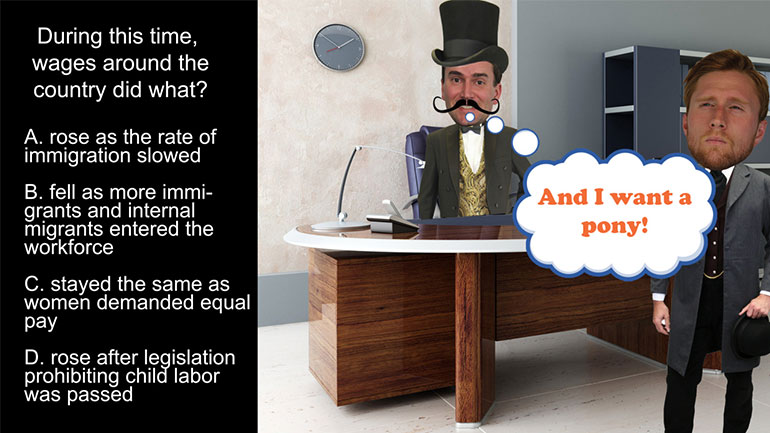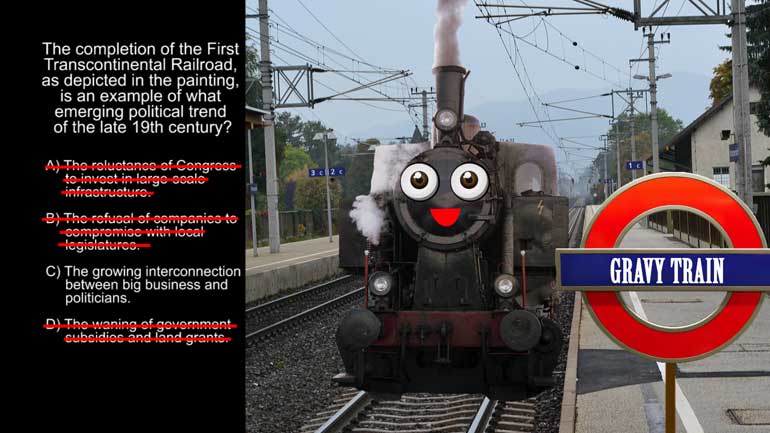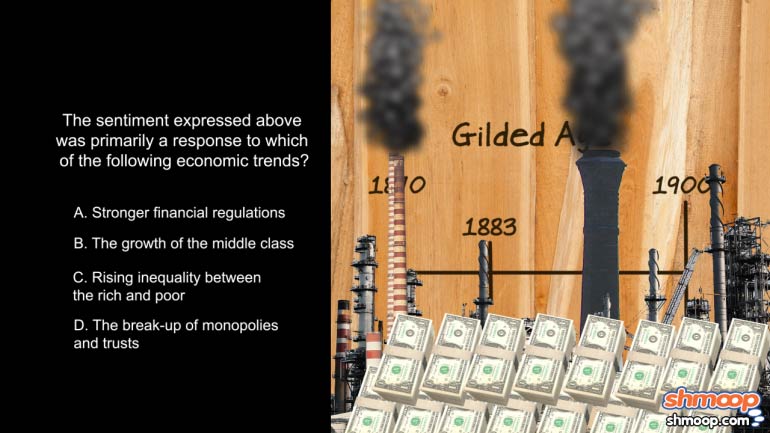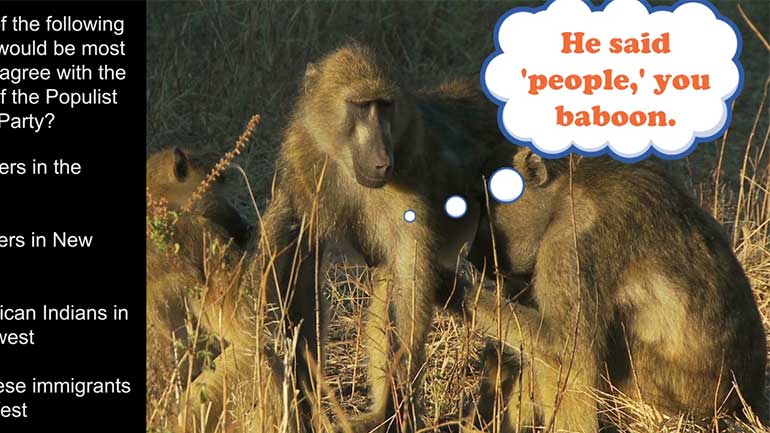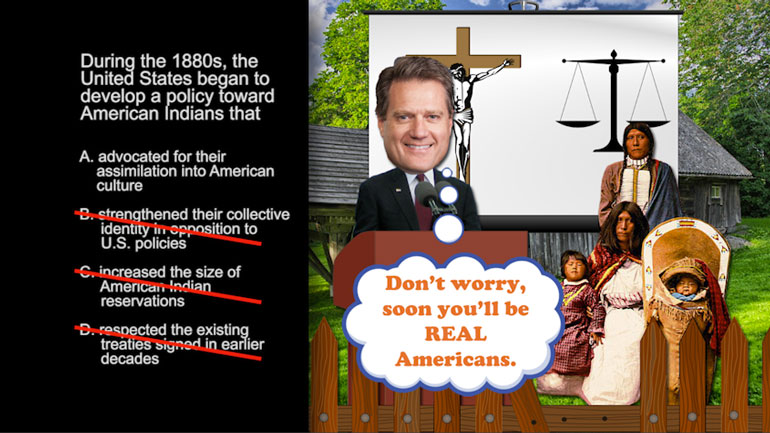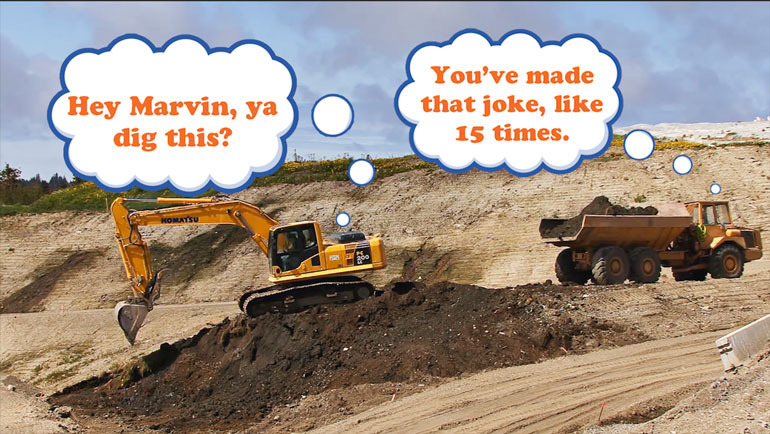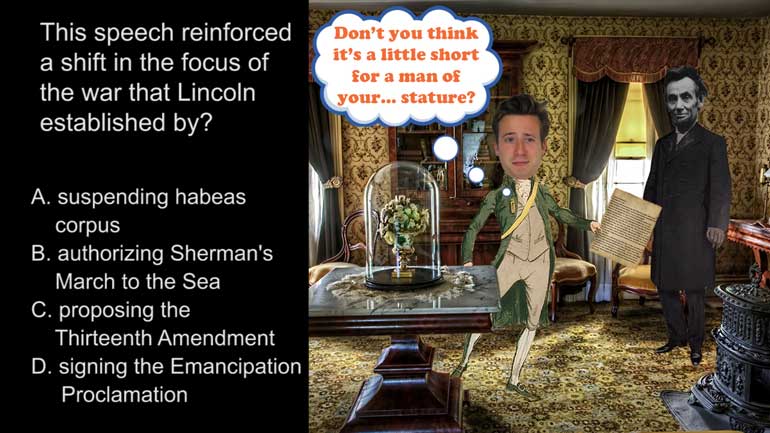ShmoopTube
Where Monty Python meets your 10th grade teacher.
Search Thousands of Shmoop Videos
Playlist U.S. History: 1865 – 1898 10 videos
How did the wealthy justify their status and privilege? Other than the customary way of having large gold statues built in their likeness with sign...
AP U.S. History 1.5 Period 6: 1865-1898. During this time, wages around the country did what?
AP U.S. History 2.1 Period 6: 1865-1898. The completion of the First Transcontinental Railroad, as depicted in the painting, is an example of what...
AP U.S. History 2.1 Period 6: 1865-1898 230 Views
Share It!
Description:
AP U.S. History 2.1 Period 6: 1865-1898. The completion of the First Transcontinental Railroad, as depicted in the painting, is an example of what emerging political trend of the late 19th century?
Transcript
- 00:00
[ musical flourish ]
- 00:03
And here's your Shmoop du jour, brought to you by the golden spike,
- 00:07
the most highly valued volleyball move in the game.
- 00:10
The completion of the First Transcontinental Railroad as depicted
- 00:13
in the painting is an example of what emerging political
Full Transcript
- 00:16
trend of the late 19th century?
- 00:18
And here are your potential answers.
- 00:23
So what exactly is this question asking?
- 00:25
We know that expanding the railroads westward was, well,
- 00:28
expansive. It involved new immigrants laying the tracks,
- 00:31
members of Congress providing incentives,
- 00:34
and wealthy industrialists counting each and every dollar they made. Ooh.
- 00:37
So we just need to figure out which answer best reflects
- 00:41
this enormous effort to make sure the trains ran on time.
- 00:44
Was the completion of the First Transcontinental Railroad
- 00:47
a reflection of A -
- 00:49
the reluctance of Congress to invest in large-scale infrastructure?
- 00:53
Quite the opposite. Congress not only endorsed the railroads,
- 00:56
but they also gave them millions of dollars in land and subsidies
- 00:59
in the process. So that means A and D are both out of the question.
- 01:03
Did laying the last spike of the First Transcontinental Railroad reflect
- 01:07
B - the refusal of companies to compromise with local legislatures?
- 01:11
Well, actually, railroad companies and local legislatures
- 01:14
cooperated all the time. Probably a bit more than they should've.
- 01:17
In the Credit-Mobilier scandal,
- 01:20
the Union Pacific Railroad set up fake corporations,
- 01:23
gave legislatures stock in exchange for land,
- 01:26
and for political favors, and then reported false earnings,
- 01:29
causing the stock to soar and get everyone rich.
- 01:32
Except the taxpayers, who eventually had to foot the bill.
- 01:36
Sounds like a solid business plan, fellas.
- 01:38
All right, well that means the completion of the First Transcontinental Railroad
- 01:41
was a reflection of C - the growing interconnection between
- 01:44
big business and politicians. Cha-ching.
- 01:47
In the late 19th century, it was all aboard with the big business
- 01:50
gravy train and politicians were no exception.
- 01:53
Corruption was rampant and politicians went out of their way
- 01:55
to befriend the tycoons, hoping they might have a
- 01:58
favor should they ever find themselves out of a job.
- 02:01
So the correct answer is C.
- 02:02
Seems like pretty much everyone was on the wrong side of the tracks.
- 02:07
[ train runs ]
Related Videos
AP U.S. History Exam 2.45. The journey shown on the map was an example of...what?
AP U.S. History Exam 2.26. This speech reinforced a shift in the focus of the war that Lincoln established by...what?
What did the Spanish messengers bring with them to North America? Hint: you probably wouldn't be thrilled to get this for your next birthday.
AP U.S. History Diagnostic 24. How did the United States choose containment over the National Security Council Report in Latin America?
AP U.S. History Exam 2.25. In writing the Gettysburg Address, Lincoln was still working to win over Northern voters who believed that...what?

